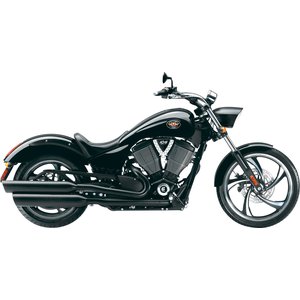Victory Vegas (2011-2017): A Timeless American Cruiser Reimagined
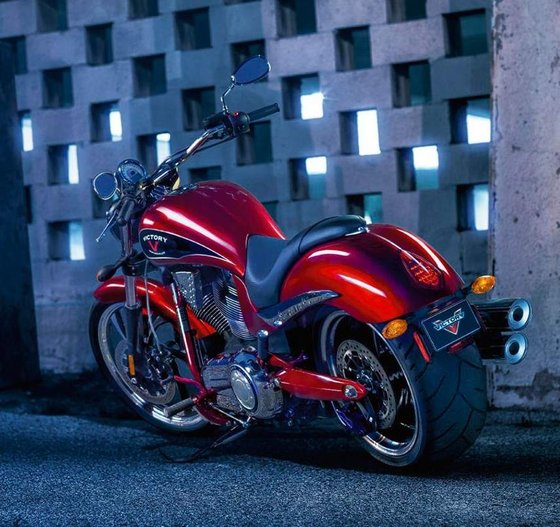
When Victory Motorcycles unveiled the Vegas lineup for 2011, they didn't just release another cruiser - they dropped a molten piece of American iron that redefined factory custom aesthetics. From 2011 through 2017, the Vegas evolved into multiple personalities - the base model, blacked-out 8-Ball, and flamboyant Jackpot - all sharing DNA that made riders feel like they were piloting a rolling art installation. Let's dissect what made this modern classic tick.
Design Philosophy: Factory Custom Perfected
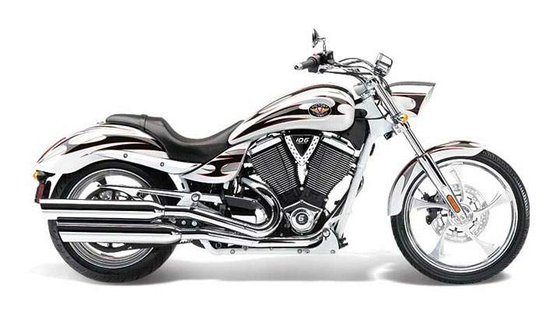
The Vegas' silhouette remains one of motorcycling's greatest magic tricks - simultaneously muscular and streamlined. That 21-inch front wheel (24-inch on Jackpot models) isn't just for show - it carves through corners with unexpected grace. The split-tail fuel tank's raised spine isn't merely decorative; it creates an optical illusion of length while providing a natural knee grip point.
Color schemes ranged from subtle (8-Ball's murdered-out black) to retina-searing (Jackpot's Sunset Red). Special editions like the Zach Ness signature model added custom-stitched seats and numbered badges, blurring lines between production bike and boutique build.
Powerplant: The 106ci Freedom V-Twin
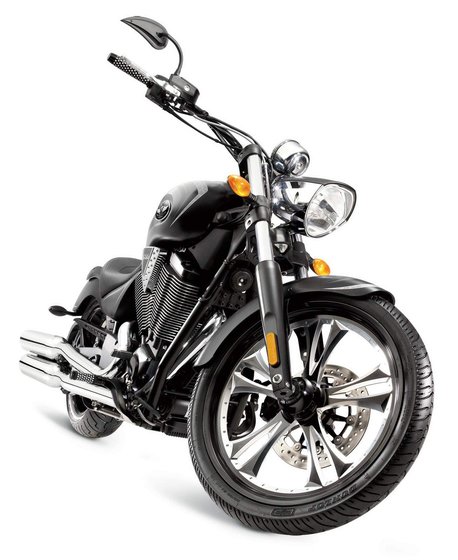
At the Vegas' heart throbs the 1,731cc (106ci) Freedom V-Twin - a 50-degree marvel producing 97 HP @ 5,000 RPM and 153 Nm (113 lb-ft) torque @ 3,000 RPM. These numbers don't tell the whole story. Stab the throttle from idle, and the counterbalanced mill delivers instant shove - enough to lift the 21-inch front wheel if you're reckless with the clutch.
The oil/air-cooled design keeps temps manageable even in summer traffic. Hydraulic lifters and self-adjusting cam chains mean you'll never need to shim valves - a blessing for those who prefer riding to wrenching. Paired with the slick 6-speed transmission (with true overdrive in 6th), it's an engine that equally enjoys burbling through downtown or devouring interstate.
Riding Dynamics: Surprising Agility Meets Classic Cruiser Comfort
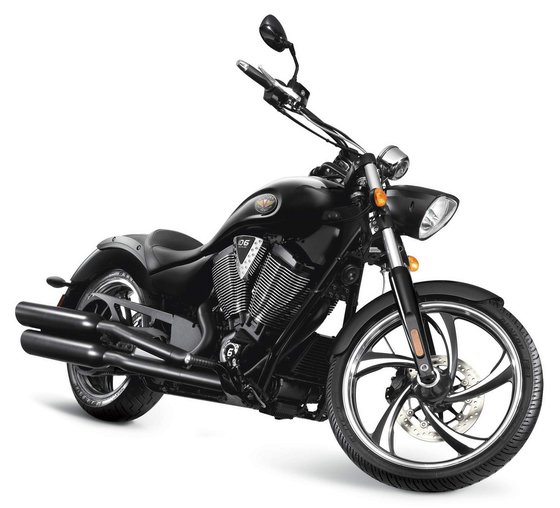
Don't let the 1,684-1,705mm (66.3-67.1") wheelbase fool you. With a 33-degree rake and 124-130mm (4.9-5.1") trail, the Vegas changes direction like a bike 100kg lighter. The secret lies in mass centralization - despite its 290-297kg (639-654 lb) dry weight, the low-slung engine keeps CG manageable.
The 640-673mm (25.2-26.5") seat (varies by model/year) accommodates all but the tallest riders, while forward controls position legs in a natural cruiser stance. Suspension travel - 130mm (5.1") front/75-100mm (3-3.9") rear - soaks up bumps adequately, though rough roads will have you scanning for smoother lines.
Braking & Wheels: Stopping Power Meets Showmanship
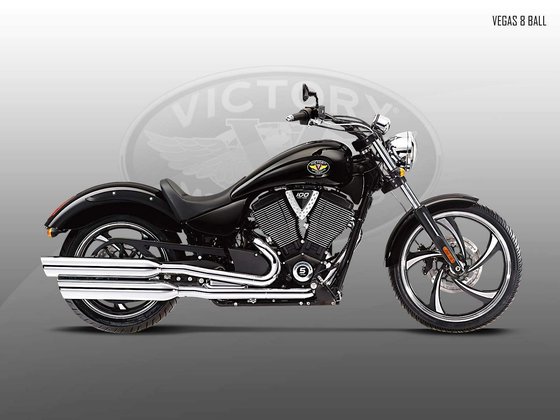
Up front, a 300mm floating rotor gripped by 4-piston calipers provides strong initial bite. The rear 300mm rotor/2-piston setup offers progressive feel - crucial when dragging brake through decreasing-radius corners. ABS became available post-2014, a welcome addition given the 250mm rear tire's (on Jackpot) tenacious grip.
Wheel designs evolved throughout the generation: - 8-Ball: Blacked-out stingray alloys (15.7 lbs lighter than previous) - Jackpot: Polished "Anvil" billet wheels - Zach Ness Edition: Custom-machined hoops
Competition: How Vegas Stood Its Ground
In the 2010s cruiser market, the Vegas squared off against formidable rivals:
Harley-Davidson Softail Slim
- Pros: Strong brand cachet, aftermarket support
- Cons: 96ci (1,584cc) engine felt anemic compared to Victory's 106ci
- Vegas Edge: 15% more torque, 40mm longer wheelbase for stability
Indian Chief Classic
- Pros: Retro styling, Thunder Stroke 111 engine
- Cons: 150kg heavier, $3k+ pricier
- Vegas Edge: More modern electronics, leaner handling
Yamaha Star Raider
- Pros: Liquid-cooled 1,854cc V-twin
- Cons: Radical styling polarizes traditionalists
- Vegas Edge: More comfortable ergonomics, easier customization
Where Vegas truly dominated was value proposition - offering 90% of a $30k custom's presence at half the price, with warranty and reliability metrics that shamed European competitors.
Maintenance: Keeping Your Vegas Rolling
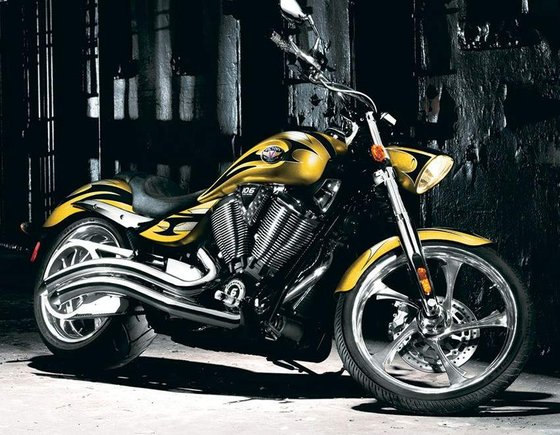
The Vegas rewards diligent owners with ironclad reliability. Key maintenance aspects:
- Oil Changes: Every 5,000 miles (8,000km) with 4.7L (5qt) of 20W-40
-
Pro Tip: Use synthetic oil to reduce engine clatter
-
Belt Drive: Inspect every 10,000 miles (16,000km)
-
Replace at 50,000 miles (80,000km) or if cracks appear
-
Brake Fluid: Flush DOT4 every 2 years
-
Upgrade to steel-braided lines for improved feel
-
Tire Pressures:
- Front: 2.6 bar (38 psi) / Rear: 2.9 bar (42 psi)
-
Consider Avon Cobra Chrome for vintage/modern blend
-
Winter Storage:
- Add fuel stabilizer to 17L (4.5gal) tank
- Keep battery on tender (18Ah capacity)
Common Upgrades from MOTOPARTS.store: - Performance air filters (+5% airflow) - Slip-on exhausts (retain torque curve) - Progressive suspension springs - Custom seat options for long-haul comfort
The Verdict: Why Vegas Still Matters
Riding a 2011-2017 Vegas today feels like discovering a lost chapter in motorcycle history - one where American manufacturers embraced innovation without sacrificing muscle. The riding position cradles you like a La-Z-Boy with handlebars, while the engine's torque curve ensures you're always in the powerband.
What surprises most modern riders is the Vegas' versatility. That 250mm rear tire (on Jackpot) isn't just for posing - it sticks like glue in corners. The 6th gear overdrive makes highway cruising serene, with the analog speedometer's blue backlight (post-2012 models) glowing like a neon sign in Vegas itself.
For those seeking a cruiser that blends showroom shine with backroad competence, the Victory Vegas generation remains a compelling choice. Its blend of industrial design and mechanical honesty creates an experience no current production cruiser can replicate - a rolling reminder that sometimes, the future arrives ahead of its time.
Specifications sheet
| Engine | |
|---|---|
| Stroke: | Four-stroke |
| Max power: | 71 kW | 95.0 hp |
| Max torque: | 153 Nm |
| Fuel system: | Electronic Fuel Injection with dual 45mm throttle body |
| Max power @: | 8800 rpm |
| Displacement: | 1731 ccm |
| Configuration: | V |
| Cooling system: | Oil & air |
| Compression ratio: | 9.4:1 |
| Number of cylinders: | 2 |
| Valves per cylinder: | 4 |
| Dimensions | |
|---|---|
| Wheelbase: | 1705 mm (67.1 in) |
| Dry weight: | 297 |
| Seat height: | 640 mm (25.2 in) |
| Overall length: | 2462 mm (96.9 in) |
| Ground clearance: | 135 mm (5.3 in) |
| Fuel tank capacity: | 17.03 L (4.5 US gal) |
| Drivetrain | |
|---|---|
| Clutch: | Wet, multi-plate |
| Final drive: | belt |
| Transmission: | 6-speed |
| Maintainance | |
|---|---|
| Rear tire: | 180/55-18 |
| Engine oil: | 20W40 |
| Front tire: | 90/90-21 |
| Brake fluid: | DOT 4 |
| Spark plugs: | NGK DCPR6E or NGK CR8E/CR8EIX |
| Spark plug gap: | 1.0 |
| Engine oil capacity: | 4.75 |
| Engine oil change interval: | Every 8000 km or 5000 mi, whichever comes first |
| Valve clearance check interval: | Hydraulic lifters (self-adjusting) |
| Recommended tire pressure (rear): | 2.9 bar (42 psi) |
| Recommended tire pressure (front): | 2.6 bar (37.7 psi) |
| Chassis and Suspension | |
|---|---|
| Trail: | 124 mm (4.9 in) |
| Rear brakes: | Single 300 mm disc, 2-piston caliper |
| Front brakes: | Single 300 mm disc, 4-piston caliper (double disc on some models) |
| Rear suspension: | Single, mono-tube gas, cast aluminum with rising-rate linkage, preload adjustable |
| Front suspension: | Conventional telescopic fork, 43 mm diameter, 130 mm travel |
| Rake (fork angle): | 32.9° |
| Rear wheel travel: | 100 mm (3.9 in) |
| Front wheel travel: | 130 mm (5.1 in) |



